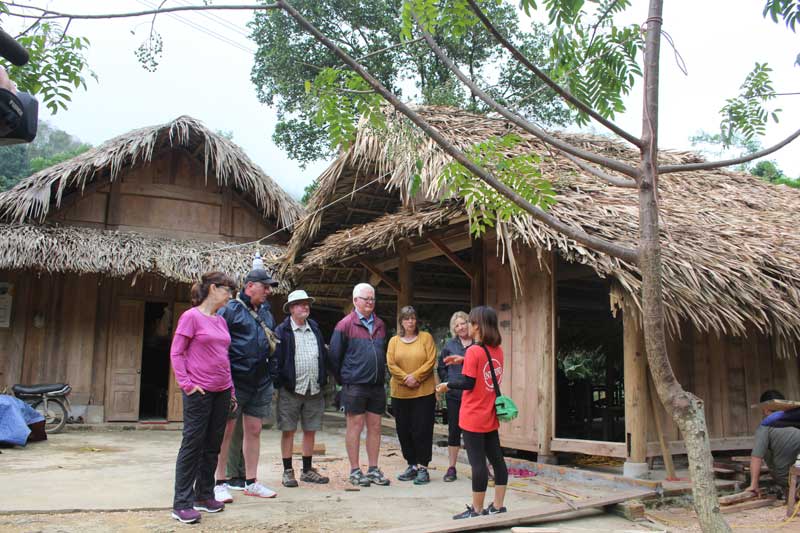
(HBO) - The housing architecture of Dao ethnic people is very diverse, depending on the group to live in the houses with ground floor or the ones with half floor and half land. Dao Tien ethnic people (Da Bac) often live in ground-floor houses with wooden walls and traditional palm-leaf roofs. They often build houses close to each other without covering walls to gather together.
 Foreign tourists are exploring and learning
about Dao culture and customs in Sung village, Cao Son commune (Da Bac).
Foreign tourists are exploring and learning
about Dao culture and customs in Sung village, Cao Son commune (Da Bac).
Sung hamlet in Cao Son commune (Da Bac) is
the home of nearly 80 Dao Tien households. The special thing when coming here
is that they do not only keep the pristine, the fresh, the friendly people, but
people are also impressed with the pristine rustic beauty imbued with Dao's
cultural identity, from the costumes and the living activities, the traditions,
the customs, the forms of cultivation and so on. In particular, this place
still maintains the ground-floor houses with traditional palm-leaf roofs built
together.
Mr. Ly Van Henh in Sung hamlet says that Dao Tien people often build
ground-floor houses with wood-grafted walls and palm-leaf roofs. This type of
house has existed for a long time, and it is very popular in the life of Dao
ethnic people. They think that only live in the ground-floor houses, there is a
place to worship Ban Vuong. Houses are usually simple with 3 or 5 standing
compartments. How big or small they are, all follow a certain pattern,
including 1 main door in the middle of the house, 1 auxiliary door on the left
gable and 2 windows. 3 compartments are arranged: the left compartment is used
to set the bedroom for the homeowner, the right compartment is the bedroom for
children, the compartment in the middle is usually wider than the other two on
the sides. It is the space for the ancestral altars and the reception.
Most of the international delegations have good
impression and promise to come back with their friends. Currently, in order to
serve tourists better, we have built more houses and improved the surrounding
landscape to ensure hygiene. The newly built house retains its wooden walls and
palm-leaf roofs, but it has been renovated with tiled floors, the bedrooms, the
kitchens, the drinking tables and chairs and many items are made of wood and
bamboo, creating the friendliness, the modern, clean and spacious appearance.
With the pristine natural beauty, the
traditional houses of Dao people, along with the unique culture of Dao Tien
people, the community tourism in Sung village has become an attractive tourism
destination for visitors to travel and explore.
With an increasingly vibrant and widespread emulation movement aimed at building cultured residential areas and cultured families, Yen Thuy District has been making steady progress toward improving both the material and spiritual well-being of its people, while fostering a civilized, prosperous, beautiful, and progressive community.
Once lacking recreational spaces and community facilities, Residential Group 2 in Quynh Lam Ward (Hoa Binh City) has recently received attention for the construction of a new, spacious, and fully equipped cultural house. The project followed the model of state support combined with public contributions in both labor and funding.
The "All people unite to build cultural life" movement, which has been effectively integrated with Kim Boi district’s socio-economic development goals, is fostering a lively spirit of emulation across local residential areas, hamlets, villages, public agencies, and enterprises. In addition, through the initiative, traditional cultural values are being preserved and promoted, while community solidarity and mutual support in poverty reduction and economic development are being strengthened.
A working delegation of the Hoa Binh provincial People’s Committee led by its Permanent Vice Chairman Nguyen Van Toan on June 11 inspected the progress of a project to build the Mo Muong Cultural Heritage Conservation Space linked to tourism services in Hop Phong commune, Cao Phong district.
Born and growing in the heroic land of Muong Dong, Dinh Thi Kieu Dung, a resident in Bo town of Kim Boi district, in her childhood was nurtured by the sweet lullabies of her grandmother and mother. These melodies deeply imprinted on her soul, becoming an inseparable part of her love for her ethnic group's culture. For over 20 years, this love for her hometown has driven Dung to research, collect, and pass down the cultural values of the Muong people to future generations.
In the final days of May, the Ethnic Art Troupe of Hoa Binh Province organized performances to serve the people in remote, mountainous, and particularly disadvantaged areas within the province. These were not just ordinary artistic shows, but they were the meaningful journeys aimed at spreading cultural values, enhancing the spiritual life of the people and contributing to the preservation of ethnic minority cultural identities.



 Foreign tourists are exploring and learning
about Dao culture and customs in Sung village, Cao Son commune (Da Bac).
Foreign tourists are exploring and learning
about Dao culture and customs in Sung village, Cao Son commune (Da Bac).